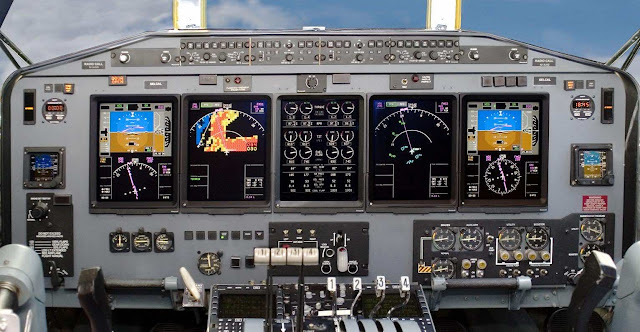In the realm of aviation, the safety and efficiency of flight are paramount. To achieve these goals, avionics and electronic components take center stage, revolutionizing the way aircraft operate. From navigation systems to communication devices and flight control systems, these technological marvels work harmoniously to ensure a smooth journey through the skies. Join us as we explore the fascinating world of avionics and electronic components and how they have become indispensable in modern aviation.
The Evolution of Avionics: From Analog to Digital
·
The
Dawn of Avionics: Analog Instruments
In the early days of aviation, pilots relied on analog
instruments to gather vital flight information. Mechanical gyroscopes, altimeters,
and airspeed indicators were instrumental in providing essential data to
pilots, helping them navigate through the skies. However, these analog systems
had their limitations, making way for the digital revolution.
·
The
Digital Era: Avionics Takes Flight
With the advent of digital technology, avionics witnessed a
remarkable transformation. Digital displays, such as primary flight displays
(PFDs) and multifunction displays (MFDs), replaced traditional gauges, offering
pilots comprehensive and intuitive data visualization. Digital avionics systems revolutionized cockpit management,
enhancing safety and pilot situational awareness.
Flight Management Systems: Guiding the Way
·
Navigating
with Precision: Inertial Navigation Systems (INS)
Inertial Navigation Systems (INS) play a vital role in modern
aviation by providing precise positioning, velocity, and attitude information
to the aircraft. Comprised of accelerometers and gyroscopes, INS systems use
advanced algorithms to calculate aircraft position relative to its initial
starting point. By continuously updating this information, pilots can
accurately determine their aircraft's location, even in the absence of external
navigation aids.
·
Satellite-Based
Navigation: GPS and GNSS
The Global Positioning System (GPS) and Global Navigation
Satellite System (GNSS) have revolutionized the way aircraft navigate
worldwide. These satellite-based systems provide real-time positioning data to
aircraft, enabling precise navigation and accurate arrival and departure times.
GPS and GNSS have become an integral part of avionics, ensuring safe and
efficient flight operations across the globe.
Communication Systems: Connecting the Skies
·
Airborne
Communication: VHF and HF Radios
VHF (Very High Frequency) and HF (High Frequency) radios
serve as the backbone of airborne communication. VHF radios facilitate
communication between aircraft and air traffic control (ATC), ensuring seamless
coordination during takeoff, landing, and throughout the flight. HF radios, on
the other hand, enable long-range communication, especially during transoceanic
flights where VHF coverage is limited.
·
Data
Exchange: ACARS and CPDLC
Aircraft Communications Addressing and Reporting System
(ACARS) and Controller-Pilot Data Link Communications (CPDLC) enable digital
data exchange between aircraft and ground stations. ACARS allows pilots to send
and receive important operational information, such as weather updates and
maintenance reports. CPDLC, on the other hand, facilitates text-based
communication between pilots and ATC, reducing voice congestion and enhancing
communication efficiency.
Flight Control Systems: The Heart of Safe Aviation
·
Autopilot:
Enhancing Precision and Safety
Autopilot systems have revolutionized the way aircraft are
flown, enabling precise control and reducing pilot workload. These systems
utilize various sensors and actuators to automatically control the aircraft's
flight parameters, such as heading, altitude, and airspeed. Autopilot
technology plays a crucial role in modern aviation, enhancing safety,
especially during long-haul flights.
·
Fly-by-Wire:
The Digital Connection
Fly-by-Wire (FBW) systems have transformed aircraft control
by replacing conventional mechanical linkages with electronic signals. FBW
systems translate pilot inputs into digital commands, enabling precise control
and optimizing flight characteristics. By eliminating the need for heavy
mechanical components, FBW systems reduce aircraft weight, enhance fuel
efficiency, and improve handling qualities.
Safety Systems: Protecting Lives in the Skies
·
Collision
Avoidance: TCAS and ADS-B
Traffic Collision Avoidance System (TCAS) and Automatic
Dependent Surveillance-Broadcast (ADS-B) play vital roles in aviation safety.
TCAS monitors nearby aircraft and provides alerts to pilots, ensuring safe
separation in congested airspace. ADS-B broadcasts an aircraft's position and
other relevant data to nearby aircraft and air traffic control, enhancing
situational awareness and reducing the risk of mid-air collisions.
·
Weather
Radar: Navigating Stormy Skies
Weather radar systems equip aircraft with the ability to
detect and navigate around hazardous weather conditions. These systems use
radar technology to analyze weather patterns and display precipitation
intensity, turbulence, and other vital information to pilots. By enabling
pilots to make informed decisions regarding weather avoidance, weather radar
systems enhance flight safety.
Conclusion:
Avionics and electronic components have become the backbone of modern
aviation, enabling safer, more efficient, and technologically advanced flight
operations. From the evolution of analog to digital instruments to the
integration of flight management systems, communication devices, flight control
systems, and safety systems, the wonders of avionics continue to revolutionize
the skies. As we move forward, these advancements will shape the future of
aviation, ensuring a seamless and secure journey for passengers and crew alike.
